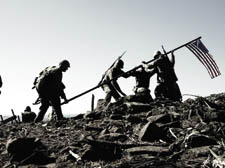|
|
 |
| |
Eastwood flies the flag
FLAGS OF OUR FATHERS
Directed by Clint Eastwood
Certificate 15
IT IS one of the most iconic images of World War II and not only raised US morale but also much needed cash for the war effort.
The sight of six American infantry soldiers pushing a flag pole up on a hill top on the heavily fortified Pacific island of Iwo Jima was used to not only remind the folks back home of the sacrifices the brave lads in the field were making, but then became an image to sell war bonds to boost the coffers of the army. Now it finds itself the subject of an engrossing film directed by Clint Eastwood.
The pic was taken by Associated Press photographer Joe Rosenthal and won him a Pulitzer Prize.
And the picture itself is superb – but also courted controversy. As with Robert Capa’s famous shot of the final moments of a Spanish civil war soldier as he is cut down by fascist bullets, the effort of the AP man has been labelled a set up.
On February 23, 1945 Rosenthal was heading towards the island to record the fighting – and was told that the volcanic summit of Mount Suribachi had been captured. He was carrying a Speed Graphic camera – the normal kit for war photographers in the US marines – and headed off to find the peak.
When he arrived the flag had already been raised, but another group of marines decided to replace it with a larger one. He arrived in time to see a group of soldiers pushing the flag upwards – and clicked his camera.
The picture later became the model for the US Marines War Memorial at their base in Arlington.
The film is based on the book by James Bradley, whose father John Bradley was one of the soldiers on Iwo Jima. With this as a basis, Eastwood manages to piece together the personal stories of the six men.
It’s a sad story. The six men in the picture did not all make it back home. Of the three that did, the rest of their time as service men was spent travelling the country recounting their war time experiences and persuading people to buy war bonds to boost the war effort.
This is not the first time the flag raising has been the subject of cinema. In 1949, John Wayne starred in the film Sands of Iwo Jima – and hands the flag to the three surviving members of the six soldiers.
It has the Stars and Stripes gloss washed all over it – something that Eastwood manages to avoid.
Eastwood the film maker is pretty similar to Eastwood the actor. His characters are tough and grizzled, and although he manages to avoid clichés, there are plenty of moments which are supposed to play into the hands of an American audience.
And there are plenty of look-away-now moments. There has been a recent vogue to make even heroic war films as real as possible. The invasion scene in Saving Private Ryan has set a trend for making battle scenes as painful as possible – and Iwo Jima was one of the bloodiest battles of the Pacific campaign.
Eastwood’s film is a fitting tribute to the horrors of war and the personal stories behind a heroic moment that came to define the fight for a generation.
|
 |
| |
|
 |
|

